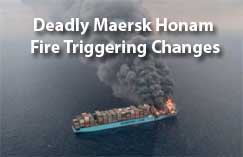As we reported at the time at the time, on March 6, a Maersk container ship caught fire in the Arabian Sea.
The Maersk Honam was in route from Singapore to the Suez Canal when a fire broke out in its cargo hull some 1,000 miles off the Oman coast.
Supply Chain Digest Says... |
|
|
Maersk said 23 crew members were evacuated to a nearby vessel named ALS Ceres after sending a distress signal when they could not extinguished the fire. Tragically, the blaze left five dead.
The fire unbelievably took some five weeks to extinguish. The 15,000-container ship was half full with 7,680 boxes. The cause of the fire is still unknown.
Then on March 15, the 5,616-TEU Maersk Kensington reported a fire in a cargo hold while in route from Salalah, Oman towards Suez. All 26 crew members were safe and accounted for, and this fire was quickly contained.
It turns out there is a container ship fire about every 60 days, according to insurer TT Club.
Now, Maersk and shipping organizations are making changes to reduce the risks – though most admit there is a limit in what can be done.
The Journal of Commerce recently reported that "It's now an unavoidable fact that the precautions traditionally taken to avoid container ship fires - such as ensuring that stowage plans comply with dangerous goods guidelines and carriers scan bills of lading for keywords indicating the possibility of mis-declared cargoes - are failing to adequately mitigate the risk to crews, cargoes, and ships.
And mis-classification – whether intentional or accidental – is a huge issue. An audit by the National Cargo Bureau in 2017, for example, found that about 4% of containers had improperly secured hazardous materials inside. 20% revealed errors in regard to the International Maritime Dangerous Goods Code and/or the vessel's Document of Compliance.
"It would be impossible to imagine error rates such as this in aviation," the JOC article commented.
(See More Below)
|
CATEGORY SPONSOR: SOFTEON |
|
|
| |
|
|
After the Homan fire, Maersk launched an in-depth review of its stowage procedures with help of the American Bureau of Shipping classification society and, without having determined the cause of the Honam fire, will nevertheless implement stowage plan changes to its fleet worldwide within the next few months, the JOC says.
That will include banning the stowage of dangerous goods cargoes near crew accommodation quarters and near the engine room, and will ban below-deck stowage in all cases of Class 5 dangerous cargoes that are resistant to firefighting.
"This was a wakeup call for us," said Ole Graa Jakobsen, Maersk's head of fleet technology.
 But a huge challenge is the reality of mis-declared good. However, because investigations and litigation stemming from container ship fires often take years and frequently are inconclusive, it's difficult to pinpoint exactly how mis-declared goods contribute to the problem. But a huge challenge is the reality of mis-declared good. However, because investigations and litigation stemming from container ship fires often take years and frequently are inconclusive, it's difficult to pinpoint exactly how mis-declared goods contribute to the problem.
But most container industry experts identify mis-declarations as a culprit in fires, even if the impact can't be quantified.
The simple fact is that mis-declared goods - whether with intent or from error - are nearly impossible to detect.
"Some believe there is no need for a stricter compliance regime because some shippers will always be motivated financially to mis-declare cargo, as they are known to do with non-dangerous cargo as well," the JOC notes.
To that point, Nils Haupt, a spokesperson for carrier Hapag-Lloyd, commented that "We actually don't believe that stricter rules on shippers would help anything. Already today, shippers have to sign a legal document, the dangerous goods declaration/container packing certificate. The shipper who today deliberately doesn't declare the respective commodities to shipping lines won't change that behavior just because of additional legal requirements."
But the JOC reports Maersk is taking a different view.
Maersk is looking at "what we can do in terms of quality control and checks to ensure that what is declared is actually what is in the container," Jakobsen said. "We see this as a root cause of some of the fires we have seen on container vessels and in container yards."
Whether the Maersk strategy will have any real impact on mid-declarations will be interesting to see – as will if new fires trigger more rules tightening or inspections on shippers.
Do you think changes need to be made to prevent container ship fires. Let us know your thoughts at the Feedback section below.
Your Comments/Feedback
|
|
Dilendra Peiris
Manager Business Development, X-PRESS FEEDERS |
Posted on: Jul, 31 2018 |
|
Legal boundary for mis-declared cargo could control the situation up to an extent. However to gain full control technology, need to play a role in the process.
I would rather suggest high-tech scanning devices to inspect containers. See, we now live in an era where VGM has become mandatory. In other terms every single container need to have a VGM certificate verifying its' weight after and before loading. After loading, at the weighing bridge itself, if scanners could be installed, I believe the issue could be controlled up to a greater extent. Legally, terms could be installed that every VGM certified unit should carry a scanner report with itself.
Another instance where this could be identified is within the port premises, at the time exports are gated in or stacked in peer for loading. a simple drive through approach through a scanner could have the situation in control.
Next level in shipping would be crypto-currencies and blockchain technology which was once a dream. Invitation would be the tech experts, as this could be a million dollar innovative approach.... |
|
|